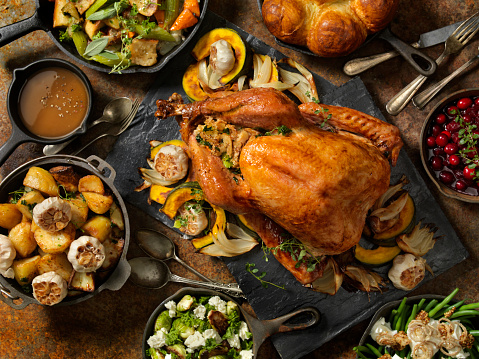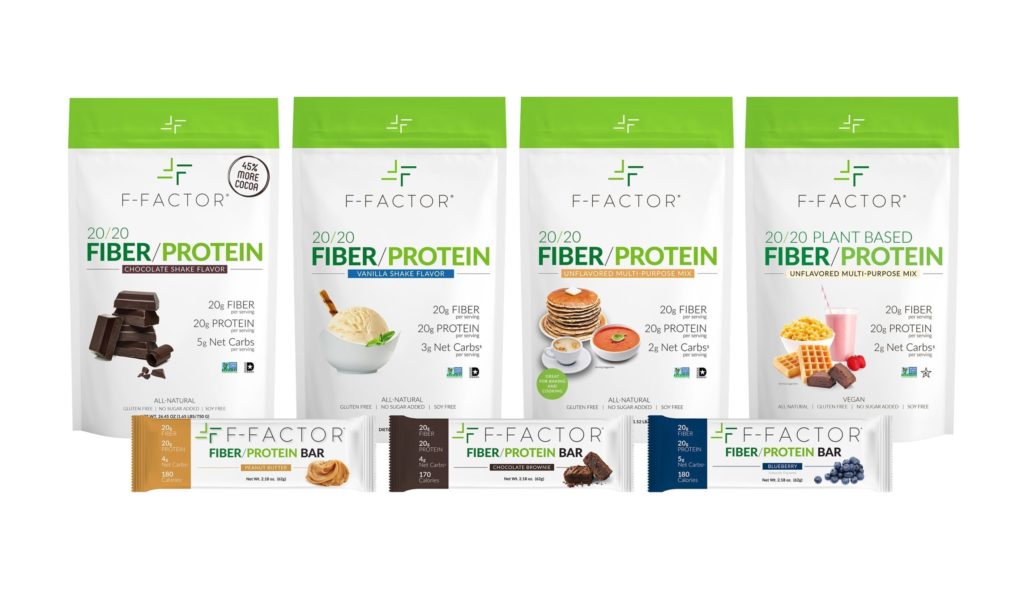There’s fiber lurking, can you find it?

How to get more fiber into your thanksgiving dinner (and why you want to)
Data shows that Thanksgiving marks the beginning of Americans’ annual weight gain – and it continues through New Year’s*. But regardless of the time of year, one strategy we always recommend to keep you from adding to the growing weight gain statistics is to find the fiber.
Fiber fills you up, and when you combine it with lean protein (which you’re practically obliged to on this turkey-centric holiday) it works even better. We say fiber and protein at every meal for a reason you know!

F-Factor bars and powders are an easy way to incorporate fiber and protein in your diet. Click the Image to see our products.
Fiber also promotes regularity, and acts like sponge in your GI tract, soaking up fat and calories from the other foods you eat and ushering them out of the body. So, if overeating marshmallow covered sweet potato casserole is your MO, fiber can also help mitigate the damage.
Considering the typical Thanksgiving meal can add up to over 3,000 calories alone (not even including seconds, drinks or apps), Turkey Day is one of the best days in the year to fill up on the good stuff (which in case you haven’t been paying attention, is FIBER). Who’s ready to play?[/su_column][/su_row]
FIND THE FIBER
Fiber is found in fruits, vegetables, whole grains and legumes. Throughout the Thanksgiving meal vegetables are going to your best friend. In addition to providing fiber, non-starchy vegetables are low calorie and have a high water content, so they’re among the best options for you to fill up on. The other big time supplier of fiber will be anything made with F-Factor 20/20 FIBER/PROTEIN Powder, which as the name suggests, packs 20g of fiber in each serving. \
APPETIZERS/ FIRST COURSE As mentioned above, vegetables are going to be your best friend at this holiday. If there’s crudités—carrots, peppers, broccoli and cucumbers—and dip served with cocktails during the appetizer portion of the night, you’re in luck. That’s because non-starchy vegetables are a free food on F-Factor, so long as they’re raw, plain or steamed with no oil, and when put out for dipping, vegetables typically are just that. This means you can have as much of them as you’d like. Just remember, this holds true just for the plain veggies, not the dips paired with it. In addition to veggies with dips (and often chips), finger foods are typical light bites served when guests arrive. Cheese, crackers and the charcuterie board will have minimal fiber, and the same goes for any crostini or puff pastry type of app. Stuffed mushrooms can pack some fiber—especially if made the F-Factor Way with wheat bran instead of bread crumbs. Crab cakes, similarly, can be made the F-Factor Way to pack some fiber. Onto the first course: soups, salads and bread. Your average dinner roll will have little fiber. Instead, consider F-Factor 20/20 biscuits which contains 8g of fiber and only 4g net carb per serving and make a great finger food for the appetizer portion of your evening. Simply divide the batter of any of the biscuit recipes to serve minis that people will gobble right up. Come meal time, move any extras to the table for people to enjoy with their soups and salads. Made with leafy greens and veggies, salads naturally will provide some fiber. Try to avoid accoutrements like dried fruit and croutons, which like candied nuts, can be so calorically dense it will outweigh the small amounts of fiber they provide. Also, if you are the person making the salad, do everyone a favor and serve it undressed/ with dressing on the side so that people can dress it to their liking. If you’re watching your weight, a broth-based soups can be a thanksgiving dish to really be thankful for. Simply put, soups are voluminous; they take up space in your stomach, which helps to fill you up, so you ultimately eat less. This is especially true when the soup is packed with fiber. While butternut squash soup is typical for Thanksgiving, consider F-Factor Carrot Ginger Soup, which packs 11g of fiber per cup! Now that’s something that will really help to fill you up before the main course. THE MAIN EVENT A typical Thanksgiving feast is centered around the bird, which as a protein, is not a source of fiber. The various side dishes will be where the fiber resides in this course, and the side that stuffs the bird is one of them. While traditionally prepared stuffing won’t have more than a gram or two of fiber, it is a side that can easily be infused with the good stuff. In addition to bulking up your recipe with non-starchy vegetables like celery, onions, mushrooms, leeks and dark leafy greens (all of which add fiber), you can swap out the fiber-less white bread for higher-fiber options, like F-Factor Everyday Waffles, or whole wheat bread. Go the waffle route and not only will your stuffing be high-fiber and only 3g net carb per serving, but gluten-free too. Appealing to the carb-conscious, vegetarians AND the gluten-free folks? This recipe is a winner. Another staple on the Thanksgiving table: cranberry sauce. While cranberries provide fiber (almost 4g per cup!), they’re usually a lot more sugar than actually cranberries when turned into your typical Turkey Day sauce. This is especially true if it’s canned and/or store-bought. Keep the sugar low and fiber high by trying Tanya’s Cran-berries Sauce, which has 4g fiber per serving. As we said before, vegetables are going to be key this holiday. Of the most typical Thanksgiving (non-starchy) vegetables, Brussels sprouts, broccoli, and cauliflower will be your best bets for low-calorie sources of fiber, with 3g, 2g, and 2g per cup respectively. Turnips also have 2g fiber per cup carrots and rutabaga both have 3g per cup. Green beans provide almost 3g fiber per cup, but if the green beans on your table are in the form of a casserole and drenched in a creamy mushroom sauce, you may not want to be eating a full cup! Potatoes (white, sweet) are a staple on the Thanksgiving table, and while they’re starchier vegetables, they do provide a little fiber. This holds true for starchy root vegetables like yams and turnips too. To maximize the fiber in your potatoes, skin is in. The skin of a potato has about a gram of fiber, so instead of your standard mashed potatoes, make them (s)mashed potatoes – AKA leave the skin on some of the potatoes. Alternatively, you can really fiber up your mash by switching from a potato mash to our Cheesy Cauliflower Mash recipe. Don’t have Unflavored 20/20 FIBER/PROTEIN Powder? Stick with our standard cauliflower mash recipe, which has 3g fiber per serving. DESSERTS Pumpkin pie anyone? Not only does pumpkin provide beta carotene, but you guessed it, fiber too. Make High Fiber Pumpkin Pie and you’re looking at a pie with 7g fiber in just one slice! While other pies, like pecan, apple, sweet potato, blueberry, may have a gram, or even two per serving, their sugar content almost always outweighs the fiber benefit. If there’s fruit on the table, berries will be your best bet for fiber. Kiwi, apple, pomegranate, star fruit and guava all contain +3g fiber per cup too. The fruits with minimal fiber? Grapes, cantaloupe and honey dew. Not bad ways to end your meal, just not the largest sources of fiber. Another sweet way to up your fiber before the night is done is with our Rustic Fruit Galette. Not only does the dish present beautifully, but each serving contains 8g of fiber! Talk about ending the meal on a (fiber) high! To help you stay on track while celebrating Thanksgiving. Shop 20/20 Fiber/Protein Powders *Susan B. Roberts, Holiday Weight Gain: Fact or Fiction?, Nutrition Reviews, Volume 58, Issue 12, December 2000, Pages 378–379, https://doi.org/10.1111/j.1753-4887.2000.tb01839.xTHANKSGIVING PRO TIPS